List of recently extinct mammals facts for kids
Recently extinct mammals are any mammal that went extinct since the year 1500 C. E., as defined by the International Union for Conservation of Nature (IUCN). Since the year 1500, roughly 80 mammal species have become extinct.
Extinction of taxa is difficult to detect as long gaps without a sighting is not definitive, but before 1995 a threshold of 50 years without a sighting was used to declare extinction.
One study found that extinction from habitat loss is the hardest to detect, as this might only fragment populations to the point of concealment from humans. Some mammals declared as extinct may very well reappear. For example, a study found that 36% of purported mammalian extinction had been resolved, while the rest either had validity issues (insufficient evidence) or had been rediscovered.
As of December 2015, the IUCN lists 30 mammalian species as "critically endangered (possibly extinct)".
Contents
Conventions
All species listed as "Extinct" are classified as being extinct (no known remaining individuals left) by the International Union for Conservation of Nature (IUCN). All species listed as Extinct in the wild are classified as being extinct in the wild, meaning that all remaining individuals of the species reside in captivity. All species listed as "Possibly extinct" are classified as being critically endangered, as it is unknown whether or not these species are extinct. Extinct subspecies such as the Javan tiger (Panthera tigris sondaica) are not listed here as the species, in this case Panthera tigris, is still extant. The IUCN Redlist classification for each species serves as a citation, and the superscripted "IUCN" by the date is a link to that species' page. A range map is provided wherever available, and a description of their former or current range is given if a range map is not available.
Causes of extinction
Habitat degradation is currently the main anthropogenic cause of species extinctions. The main cause of habitat degradation worldwide is agriculture, with urban sprawl, logging, mining and some fishing practices close behind. The physical destruction of a habitat, both directly (deforestation for land development or lumber) and indirectly (burning fossil fuels), is an example of this.
Also, increasing toxicity, through media such as pesticide, can kill off a species very rapidly, by killing all living members through contamination or sterilizing them. Persistent organic pollutant (POPs), for example, can bioaccumulate to hazardous levels, getting increasingly more dangerous further up the food chain.
Disease can also be a factor; white nose syndrome in bats, for example, is causing a substantial decline in their populations and may even lead to the extinction of a species.
Overhunting also has an impact. Terrestrial mammals, such as the tiger and deer, are mainly hunted for their pelts and in some cases meat, and marine mammals can be hunted for their oil and leather. Specific targeting of one species can be problematic to the ecosystem because the sudden demise of one species can inadvertently lead to the demise of another (coextinction) especially if the targeted species is a keystone species. Sea otters, for example, were hunted in the maritime fur trade, and their drop in population led to the rise in sea urchins—their main food source—which decreased the population of kelp—the sea urchin's and Steller's sea cow's main food source—leading to the extinction of the Steller's sea cow. The hunting of already limited species can easily lead to its extinction, as with the bluebuck whose range was confined to 1,700 square miles (4,400 km2) and was hunted into extinction soon after discovery by European settlers.
Australia
Island creatures are usually endemic to only that island, and that limited range and small population can leave them vulnerable to sudden changes. Australia and its unique fauna have suffered an extreme decline in mammal species, 10% of its 273 terrestrial mammals, since European settlement (a loss of one to two species per decade); in contrast, only one species in North America has become extinct since European settlement. Furthermore, 21% of Australia's mammals are threatened, and unlike in most other continents, the main cause is predation by feral species, such as cats.
Extinct species
A species is declared extinct after exhaustive surveys of all potential habitats eliminate all reasonable doubt that the last individual of a species, whether in the wild or in captivity, has died. Recently extinct species are defined by the IUCN as going extinct after 1500 C. E.
| Common name | Binomial name | Order | Date of extinction | Former range | Picture |
|---|---|---|---|---|---|
| Broad-faced potoroo | Potorous platyops Gould, 1844 |
Diprotodontia | 1875 | Australia | 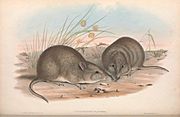 |
| Eastern hare wallaby | Lagorchestes leporides Gould, 1841 |
Diprotodontia | 1889 | 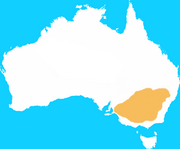 Australia |
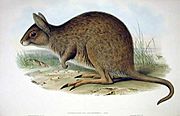 |
| Lake Mackay hare-wallaby | Lagorchestes asomatus Finlayson, 1943 |
Diprotodontia | 1932 | Australia | |
| Desert rat-kangaroo | Caloprymnus campestris Gould, 1843 |
Diprotodontia | 1935 |  Australia |
 |
| Tasmanian tiger, or Tasmanian wolf | Thylacinus cynocephalus Harris, 1808 |
Dasyuromorphia | 1936 | 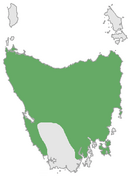 Australia, Tasmania |
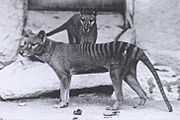 |
| Toolache wallaby | Macropus greyi Waterhouse, 1846 |
Diprotodontia | 1939 | Australia | 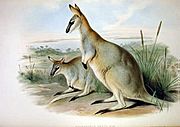 |
| Desert bandicoot | Perameles eremiana Spencer, 1837 |
Peramelemorphia | 1943 | Australia | |
| Lesser bilby, or yallara | Macrotis leucura Thomas, 1887 |
Peramelemorphia | 1931 | 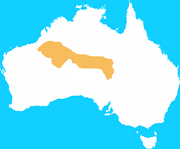 Australia |
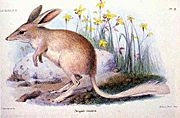 |
| Pig-footed bandicoot | Chaeropus ecaudatus Ogilby, 1838 |
Peramelemorphia | 1950s | 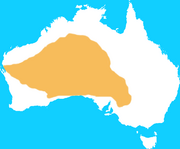 Australia |
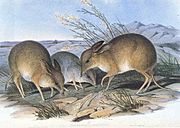 |
| Crescent nailtail wallaby | Onychogalea lunata Gould, 1841 |
Diprotodontia | 1956 | Australia (western and central) | 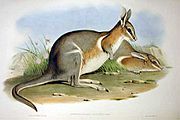 |
| Red-bellied gracile opossum, or Red-bellied gracile mouse opossum | Cryptonanus ignitus Díaz, Flores and Barquez, 2002 |
Didelphimorphia | 1962 | Argentina | |
| Nullarbor dwarf bettong | Bettongia pusilla McNamara, 1997 |
Diprotodontia | 1500
|
Australia, Nullarbor Plain | |
| Steller's sea cow | Hydrodamalis gigas von Zimmermann, 1780 |
Sirenia | 1768 | Commander Islands | 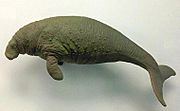 |
| Bramble Cay melomys | Melomys rubicola Thomas, 1924 |
Rodentia |
|
Australia, Bramble Cay |  |
| Oriente cave rat | Boromys offella Miller, 1916 |
Rodentia | 1500
|
Cuba |  |
| Torre's cave rat | Boromys torrei Allen, 1917 |
Rodentia | 1500
|
Cuba | 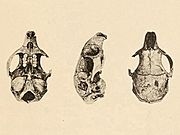 |
| Imposter hutia | Hexolobodon phenax Miller, 1929 |
Rodentia | 1500
|
Hispaniola | |
| Montane hutia | Isolobodon montanus Miller, 1922 |
Rodentia | 1500
|
Hispaniola | |
| Lagostomus crassus Thomas, 1910 |
Rodentia | 1900
|
Peru | ||
| Galápagos giant rat | Megaoryzomys curioi Niethammer, 1964 |
Rodentia | 1500s | Santa Cruz Island, Galápagos |  |
| Cuban coney | Geocapromys columbianus Chapman, 1892 |
Rodentia | 1500
|
Cuba | |
| Hispaniolan edible rat | Brotomys voratus Miller, 1916 |
Rodentia | 1536–1546 | Hispaniola | |
| Puerto Rican hutia | Isolobodon portoricensis Allen, 1916 |
Rodentia | 1900
|
Hispaniola and introduced to Puerto Rico, Saint Thomas Island, Saint Croix Island and Mona Island | |
| Big-eared hopping mouse | Notomys macrotis Thomas, 1921 |
Rodentia | 1843 | Australia (central Western Australia) | |
| Darling Downs hopping mouse | Notomys mordax Thomas, 1921 |
Rodentia | 1846 | Australia (Darling Downs, Queensland) | |
| White-footed rabbit-rat | Conilurus albipes Lichtenstein, 1829 |
Rodentia | 1860
|
Australia, eastern coast | 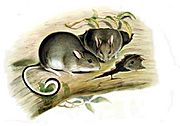 |
| Capricorn rabbit rat | Conilurus capricornensis Cramb and Hocknull, 2010 |
Rodentia | 1500
|
Australia, Queensland | |
| St Lucy giant rice rat, or Santa Lucian pilorie | Megalomys luciae Major, 1901 |
Rodentia | 1881 | Saint Lucia | 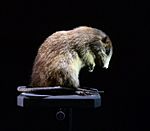 |
| Short-tailed hopping mouse | Notomys amplus Brazenor, 1936 |
Rodentia | 1896 | Australia, Great Sandy Desert | |
| Nelson's rice rat | Oryzomys nelsoni Merriam, 1889 |
Rodentia | 1897 | Islas Marías |  |
| Long-tailed hopping mouse | Notomys longicaudatus Gould, 1844 |
Rodentia | 1901 | Australia | |
| Great hopping mouse | Notomys robustus Mahoney, Smith and Medlin, 2008 |
Rodentia | 1500
|
Australia, Flinders and Davenport Ranges | |
| Desmarest's pilorie, or Antillean giant rice rat | Megalomys desmarestii Fischer, 1829 |
Rodentia | 1902 | Martinique |  |
| Bulldog rat | Rattus nativitatis Thomas, 1888 |
Rodentia | 1903 | Christmas Island |  |
| Maclear's rat | Rattus macleari Thomas, 1887 |
Rodentia | 1903 | Christmas Island |  |
| Darwin's Galapagos mouse | Nesoryzomys darwini Osgood, 1929 |
Rodentia | 1930 | Galapagos Islands | |
| Gould's mouse | Pseudomys gouldii Waterhouse, 1839 |
Rodentia | 1930 | Australia, southern half | 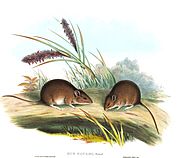 |
| Long-eared mouse | Pseudomys auritus Thomas, 1910 |
Rodentia | 1800
|
Australia, Kangaroo Island and the Younghusband Peninsula | |
| Pemberton's deer mouse | Peromyscus pembertoni Burt, 1932 |
Rodentia | 1931 | San Pedro Nolasco Island | |
| Samana hutia | Plagiodontia ipnaeum Johnson, 1948 |
Rodentia | 1500
|
Hispaniola | |
| Lesser stick-nest rat, or white-tipped stick-nest rat | Leporillus apicalis John Gould, 1854 |
Rodentia | 1933 | Australia, west-central | 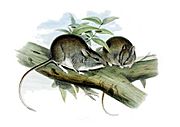 |
| Indefatigable Galapagos mouse | Nesoryzomys indefessus Thomas, 1899 |
Rodentia | 1934 | Galapagos Islands | |
| Little Swan Island hutia | Geocapromys thoracatus True, 1888 |
Rodentia | 1955 | Swan Islands | 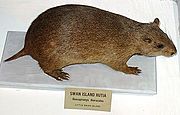 |
| Blue-gray mouse | Pseudomys glaucus Thomas, 1910 |
Rodentia | 1956 | Australia, Queensland and New South Wales | |
| Buhler's coryphomys, or Buhler's rat | Coryphomys buehleri Schaub, 1937 |
Rodentia | 1500
|
Timor | |
| Insular cave rat | Heteropsomys insulans Anthony, 1916 |
Rodentia | 1500
|
Puerto Rico and the Vieques Island | |
| Candango mouse | Juscelinomys candango Moojen, 1965 |
Rodentia | 1960 | Central Brazil | |
| Anthony's woodrat | Neotoma anthonyi Allen, 1898 |
Rodentia | 1926 | Isla Todos Santos | |
| Bunker's woodrat | Neotoma bunkeri Burt, 1932 |
Rodentia | 1931 | Coronado Islands | |
| San Martín Island woodrat | Neotoma martinensis Goldman, 1905 |
Rodentia | 1950s | San Martín Island, Baja California | |
| Vespucci's rodent | Noronhomys vespuccii Carleton and Olson, 1999 |
Rodentia | 1500 | Fernando de Noronha | |
| St. Vincent colilargo, or St. Vincent pygmy rice rat | Oligoryzomys victus Thomas, 1898 |
Rodentia | 1892 | Saint Vincent | |
| Jamaican rice rat | Oryzomys antillarum Thomas, 1898 |
Rodentia | 1877 | Jamaica | 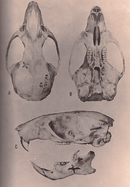 |
| Nevis Rice Rat, or St. Eustatius rice rat, St. Kitts rice rat | Pennatomys nivalis Turvey, Weksler, Morris, and Nokkert, 2010 |
Rodentia | 1500
|
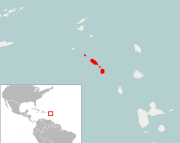 |
|
| Christmas Island pipistrelle | Pipistrellus murrayi Andrews, 1900 |
Chiroptera | 2009 | Christmas Island | |
| Sardinian pika | Prolagus sardus Wagner, 1832 |
Lagomorpha | 1774 | Corsica, Sardinia and nearby islands | 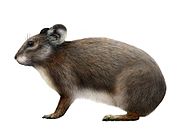 |
| Marcano's solenodon | Solenodon marcanoi Patterson, 1962 |
Soricomorpha | 1500s | Dominican Republic | |
| Puerto Rican nesophontes | Nesophontes edithae Anthony, 1916 |
Eulipotyphla | 1500
|
Puerto Rico, Vieques Island, St. John, and St. Thomas | 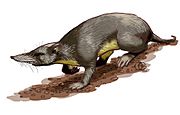 |
| Atalaye nesophontes | Nesophontes hypomicrus Miller, 1929 |
Eulipotyphla | 1500
|
Hispaniola | |
| Greater Cuban nesophontes | Nesophontes major Arredondo, 1970 |
Eulipotyphla | 1500
|
Cuba | |
| Western Cuban nesophontes | Nesophontes micrus Allen, 1917 |
Eulipotyphla | 1500
|
Cuba and the Isla de la Juventud | |
| St. Michel nesophontes | Nesophontes paramicrus Miller, 1929 |
Eulipotyphla | 1500
|
Haiti | |
| Haitian nesophontes | Nesophontes zamicrus Miller, 1929 |
Eulipotyphla | 1500
|
Haiti | |
| Lesser Mascarene flying fox, or dark flying fox | Pteropus subniger kerr, 1792 |
Chiroptera | 1864 | Réunion and Mauritius |  |
| Guam flying fox, or Guam fruit bat | Pteropus tokudae Tate, 1934 |
Chiroptera | 1968 | Guam | |
| Dusky flying fox, or Percy Island flying fox | Pteropus brunneus Dobson, 1878 |
Chiroptera | 1870 | Percy Island | |
| Large Palau flying fox | Pteropus pilosus Andersen, 1908 |
Chiroptera | 1874 | Palau | |
| Large sloth lemur | Palaeopropithecus ingens Grandidier, 1899 |
Primate | 1620 | 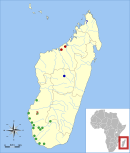 In green |
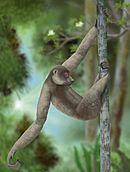 |
| Jamaican monkey | Xenothrix mcgregori Williams and Koopman, 1952 |
Primate | 1700
|
Jamaica, Long Mile Cave | |
| Aurochs | Bos primigenius Bojanus, 1827 |
Artiodactyla | 1627 | 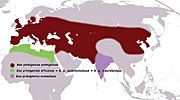 |
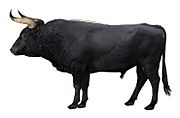 |
| Bluebuck | Hippotragus leucophaeus Pallas, 1766 |
Artiodactyla | 1800 |  |
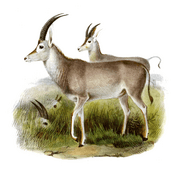 |
| Red gazelle | Eudorcas rufina Thomas, 1894 |
Artiodactyla | 1800
|
Algeria | 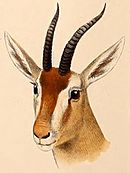 |
| Schomburgk's deer | Rucervus schomburgki Blyth, 1863 |
Artiodactyla | 1932 | Thailand | 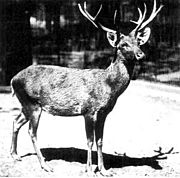 |
| Queen of Sheba's gazelle, or Yemen gazelle | Gazella bilkis Grover and Lay, 1985 |
Artiodactyla | 1951 | Yemen | |
| Saudi gazelle | Gazella saudiya Carruthers and Schwarz, 1935 |
Artiodactyla | 2008 | Arabian Peninsula | |
| Madagascan dwarf hippopotamus, or Malagasy hippo | Hippopotamus lemerlei Milne-Edwards, 1868 |
Artiodactyla | 1500
|
Madagascar | 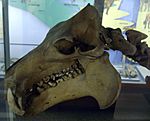 |
| Madagascan dwarf hippopotamus, or Madagascan pygmy Hippo, Malagasy hippo | Hippopotamus madagascariensis Guldberg, 1883 |
Artiodactyla | 1500
|
Madagascar |  |
| Falkland Islands wolf, or warrah | Dusicyon australis Kerr, 1792 |
Carnivora | 1876 | Falkland Islands | 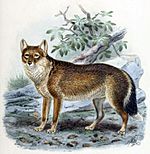 |
| Dusicyon avus Burmeister, 1866 |
Carnivora | 1500
|
Patagonia | ||
| Sea mink | Neovison macrodon Prentiss, 1903 |
Carnivora | 1894 | Northeastern North America | |
| Japanese sea lion | Zalophus japonicus Peters, 1866 |
Carnivora | 1970s | Japan | 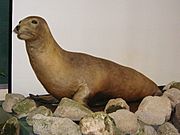 |
| Caribbean monk seal | Neomonachus tropicalis Gray, 1850 |
Carnivora | 1952 | Caribbean Sea |  |
| Giant fossa | Cryptoprocta spelea Grandidier, 1902 |
Carnivora | 1500
|
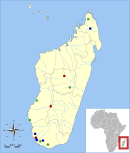 |
 |
Extinct in the wild
A species that is extinct in the wild is one which has been categorized by the International Union for Conservation of Nature (IUCN) as only known by living members kept in captivity or as a naturalized population outside its historic range due to massive habitat loss. A species is declared extinct in the wild after thorough surveys have inspected its historic range and failed to find evidence of a surviving individual.
| Common name | Binomial name | Order | Date of extinction | Former range | Picture |
|---|---|---|---|---|---|
| Père David's deer | Elaphurus davidianus Milne-Edwards, 1866 |
Artiodactyla | 1939 | China | 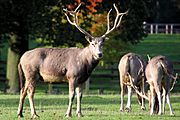 |
| Scimitar oryx | Oryx dammah Cretzschmar, 1827 |
Artiodactyla | 2000 | Sahara desert |  |
Possibly extinct
Extinction of taxa is difficult to detect as long gaps without a sighting is not definitive. Some mammals declared as extinct may very well reappear. For example, a study found that 36% of purported mammalian extinction had been resolved, while the rest either had validity issues (insufficient evidence) or had been rediscovered. As of December 2015, the IUCN lists 30 mammalian species as "critically endangered (possibly extinct)".
| Common name | Binomial name | Order | Last confirmed sighting | Range | Picture |
|---|---|---|---|---|---|
| Kouprey, or gray ox, forest ox | Bos sauveli Urbain, 1937 |
Artiodactyla | 1988 |  |
|
| Garrido's hutia | Capromys garridoi Varona, 1970 |
Rodentia | 1989 | Cayo Maja | |
| Christmas Island shrew | Crocidura trichura Dobson, 1889 |
Rodentia | 1985 | 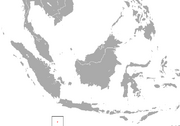 |
|
| Wimmer's shrew | Crocidura wimmeri de Balsac and Aellen, 1958 |
Rodentia | 1976 | 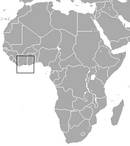 |
|
| De Winton's golden mole | Cryptochloris wintoni Broom, 1907 |
Rodentia | 1937 | 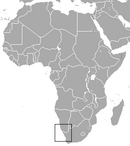 |
|
| Wondiwoi tree-kangaroo | Dendrolagus mayri Rothschild and Dollman, 1933 |
Diprotodontia | 2018 | Papua New Guinea, Wondiwoi Peninsula | |
| Baiji, or Yangtze river dolphin, whitefin dolphin, white flag dolphin, Chinese lake dolphin, Changjiang dolphin | Lipotes vexillifer Miller, 1918 |
Cetacea | 2002 | 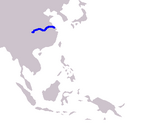 |
 |
| Zuniga's dark rice rat | Melanomys zunigae Sanborn |
Rodentia | 1949 | Peru, Lomas de Atocongo (hills near Lima) | |
| Dwarf hutia | Mesocapromys nanus Allen, 1917 |
Rodentia | 1937 | Ciénaga de Zapata | |
| San Felipe hutia, or little Earth hutia | Mesocapromys sanfelipensis Varona & Garrido, 1970 |
Rodentia | 1978 | Cuba | |
| One-striped opossum | Monodelphis unistriata Wagner, 1842 |
Didelphimorphia | 1899 | 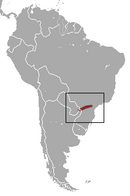 |
|
| Gloomy tube-nosed bat | Murina tenebrosa Yoshiyuki, 1970 |
Chiroptera | 1962 | Tsushima Island and possibly Yaku Island | |
| New Zealand greater short-tailed bat | Mystacina robusta Dwyer, 1962 |
Chiroptera | 1967 | Big South Cape Island |  |
| Ethiopian amphibious rat, or Ethiopian water mouse | Nilopegamys plumbeus Osgood, 1928 |
Rodentia | 1920s | Mouth of the Lesser Abay River | |
| Lord Howe long-eared bat | Nyctophilus howensis McKean, 1975 |
Chiroptera | 1972 | Lord Howe Island | |
| Angel Island mouse | Peromyscus guardia Townsend, 1912 |
Rodentia | 1991 | Isla Ángel de la Guarda | |
| Puebla deer mouse | Peromyscus mekisturus Merriam, 1898 |
Rodentia | 1950s | Ciudad Serdan and Tehuacán | |
| Telefomin cuscus | Phalanger matanim Flannery, 1987 |
Diprotodontia | 1997 |  |
|
| Montane monkey-faced bat | Pteralopex pulchra Flannery, 1991 |
Chiroptera | 1990s | 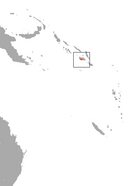 |
|
| Aru flying fox | Pteropus aruensis Peter, 1867 |
Chiroptera | 1992 |  |
|
| Vanikoro flying fox | Pteropus tuberculatus Peters, 1869 |
Chiroptera | 1980
|
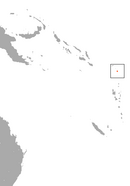 |
|
| Emma's giant rat | Uromys emmae Groves and Flannery, 1994 |
Rodentia | 1990s | Owi Island of the Paidaido Islands, Papua Province | |
| Emperor rat | Uromys imperator Thomas, 1888 |
Rodentia | 1888 | Guadalcanal | |
| Guadalcanal rat | Uromys porculus Thomas, 1904 |
Rodentia | 1888 | Guadalcanal | |
| Central rock rat | Zyzomys pedunculatus Waite, 1896 |
Rodentia | 2001 |  |
 |
| Malabar large-spotted civet, or Malabar civet | Viverra civettina Blyth, 1862 |
Carnivora | 1980
|
 |
|
| Bouvier's red colobus | Piliocolobus bouvieri Groves, 2007 |
Primate | 2015 | Right bank of the Congo river |
See also
 In Spanish: Anexo:Mamíferos extintos en época histórica para niños
In Spanish: Anexo:Mamíferos extintos en época histórica para niños


